Teotihuacan Ciudadela (Citadel) The Ciudadela is an immense sunken square, nearly seventeen acres in extent, situated at the very center of Teotihuacan, near the point where the Street of the Dead crosses the East-West Street. Part of the original plan for the city, the Ciudadela was the parade ground, religious center, city-state capital, and maybe lots more. It was large enough to accommodate festivals and ceremonies (anachronistically, we might say political rallies) for as many as 100,000 people. |
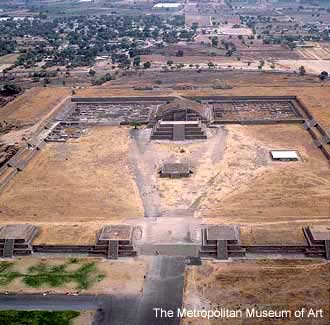
|
Within the surrounding wall, which allowed for controlled access, the focus of the complex was the large Pyramid of the Feathered Serpent, flanked by two structures, which may have been residences for dignitaries and other important people as well as administrative facilities, where excavation continues today. 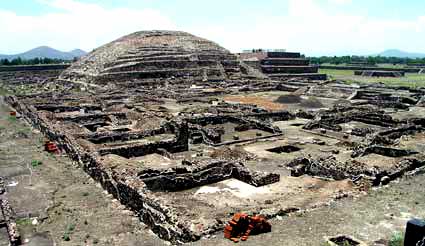 |
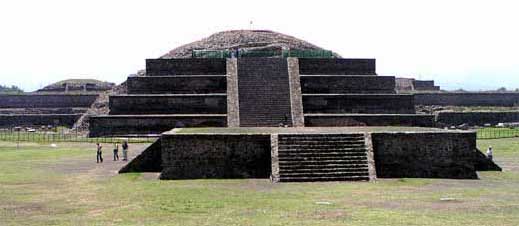 |
The early 3rd century Pyramid of the Feathered Serpent (FSP) is the smallest and the latest of the three monumental pyramids at Teotihuacan (see comments about the Moon and Sun pyramids on following pages). As the aerial photo above shows, it dominates the Ciudadela, although there is some evidence that the enclosure wall may have predated the pyramid itself. The people standing to the left of the platform at the center of the Ciudadela testify to the size of the buildings, of which three are shown here: the center platform, the "Adosada platform" (the tiered structure), and the Pyramid of the Feathered Serpent itself. |
 |
This pyramid, including its Adosada ("leaning") platform, tells a tale, a tale of civil strife, of pain and anguish. The tale is known only as an outline drawn by archaeologists and, as all such tales, relies in part on surmise and imagination—for stones and bones and artifacts speak sometimes with muted voice. The pyramid, which at one time was crowned by a temple, was entirely covered with incredible raised relief and sculptured Feathered Serpents, carrying on their backs a strange google-eyed figure that has been determined to be the representation of a mask worn by warriors.
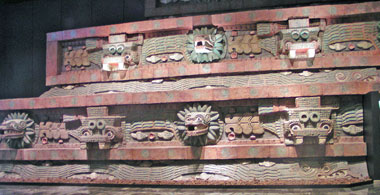 |

|
Then, writhing below, are other serpents that are obscured by plastic sheeting in the picture at right (above) but visible in a reconstruction at the Museo Nacional de Antropologia in Mexico City. Scattered among the figures of both serpents are shells and snails, suggesting that their milieu featured water. But since the Teotihuacanos apparently were innocent of writing, we are left only with the myths of their neighbors and descendents for help in comprehending the significance of these monstrous snakes. For instance, a Maya myth has two snakes wriggling in the primal ocean. One, the Feathered Serpent or Quetzalcoatl, represents life and peace. The other, perhaps a Fire Serpent, represents the hot desert and war. Together they forge the first moments of creation (Coe & Koontz, 108). The distinctive Teotihuacan architectural style, called talud-tablero, is fully developed at this Quetzalcoatl pyramid. The Feathered Serpent, with the warrior headdress on its back, is on the tablero, while the Fire Serpent squirms along on the talud. The museum reconstruction suggests how the facade might have looked with its original paint. |  |
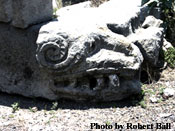 |
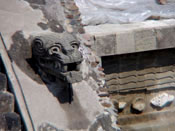 |
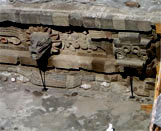 |
A fallen serpent head |
Feathered Serpent emerging from the stairway balustrade |
A glimpse of the Fire serpent |
Scroll back up to the photograph of the pyramid complex and notice that the pyramid looks more like a rounded hill than it does a pyramid. In fact, it is (or was) a 7-tiered step pyramid with a temple on top, covered with Feathered Serpents. The temple is long gone, of course, as are most of the Feathered Serpents. So what happened to them? The normal wear and tear of centuries-long wind, rain, and predation can account for some of the loss. But in this case there may also be a more sinister explanation—which stems from its very beginning. |
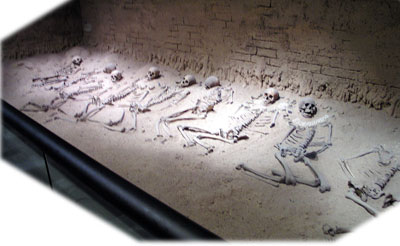 |
It seems that this pyramid was built in a single construction episode (unlike the earlier Moon and Sun pyramids) in or around 200 CE. A project of that scope could only have been conceived and completed under the direction of powerful political (including religious) leadership. Such leadership would have been necessary also to command that more than 200 human sacrifices be performed in the pyramid/temple's dedication. A large burial pit was found on the north side of the pyramid and another on the south. In each were skeletons of eighteen young men—soldiers. Their hands were tied behind their backs and around their necks were strings of human jaws, both real and artificial. Other pits contained the remains of young women. Neither was the east-west axis ignored; more graves of sacrificed victims were found there. |
The grave reproduction in the Museo Nacional de Antropologia is one of those on the east, or "back," side of the pyramid. But that wasn't all. A single victim was found at each of the building's four corners. And, in the very center (grave 14) were twenty skeletons accompanied by thousands of lavish offerings. (The plan of the pyramid was photographed at Arizona State University's research facility at Teotihuacan.) |
What's going on here? What prompted the immense expenditure of manual labor, artistic skill, and treasure, not to mention lives, that produced one of the largest and arguably the most elaborately decorated pyramid in the Americas? Perhaps the graves at the heart of the pyramid provide a clue. When archaeologists tunneled into the pyramid from the south side they discovered mass graves—grave 2 contained eight females and in grave 4 were eighteen males with goods that identified them as soldiers. As the archaeologists approached the center of the structure they broke through, most unexpectedly, to another tunnel that antedated them by hundreds of years. Looters, as is so often the case, had already been there. The looters in this case had not been scavenging collectibles to sell on eBay. They were Teotihuacanos searching for treasure or, perhaps, intentionally desecrating graves, beginning probably within a hundred years of the sacrifices. |
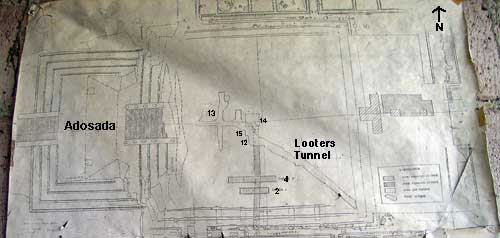 |
The looters had pretty well cleaned out two of the graves at the heart of the pyramid, graves 12 and 15, but enough was left for the archaeologists to determine that at least one of the graves had been used prior to the building of the pyramid and the other had been used twice and looted twice. Remnants of high status grave goods were also found. But the looters had not gotten to the grave, 14, that was at the precise center of the huge building. There twenty people had been sacrificed, along with the richest trove of offerings yet found at Teotihuacan. Unlike other burials, which were in pits, these twenty had simply been stretched out on the ground and the pyramid built over them. The skeletons were all jumbled up, some on top of others. Who's to know? Were they buried alive? |
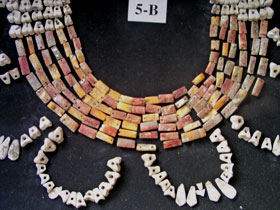 |
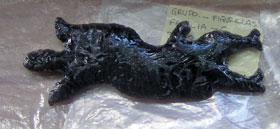
Curated at the Arizona State University research facility are hundred of artifacts like these that were found with the sacrificed victims buried in and near the Feathered Serpent Pyramid. |
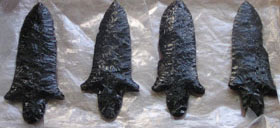
Arrowheads are only some of the indications that sacrificed males were soldiers. The torque is decorated with rings of teeth. But what is the flint object at center? |
A lot of people were intentionally put to death when this pyramid and its temple were built. Some of them were women but most were men and not just men, soldiers. Significantly, they were not enemy soldiers, not captives. They were soldiers in the Teotihuacan army. Local boys—plus local girls. Everything about the pyramid suggests a military cult: the sacrificial victims identified as soldiers, the military headdress carried by the Feathered Serpents on the facade and, indeed, the discipline required to effect the sacrifices and the construction of the edifice. |
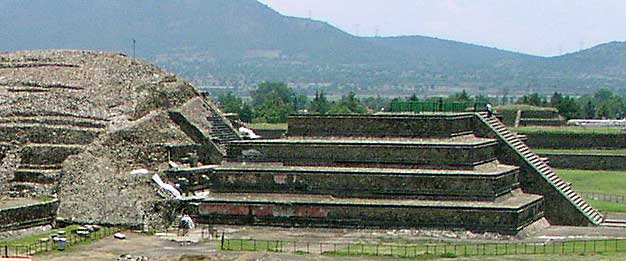 |
A logical first thought about the pyramid, therefore, would be to search for a grave containing a powerful ruler for whom the pyramid was a mausoleum and the sacrificial victims retainers. But to date no such grave has been found, although "elite" artifacts were discovered in some of the graves, e.g., grave 13. It would appear that all of the burials that accompanied the dedication of the pyramid were sacrifices, all 200 or so of them. Which brings us back to the looters and to the Adosada Platform. |
 |
The Feathered Serpent Pyramid was built early in the 3rd century (just to make the numbers round let's say 200) and the 200+ human sacrifices were dedicated to it then. By the early 4th century—let's say 300—Teotihuacan had more than 400 years of flourishing future ahead of it. But the Feathered Serpent Pyramid, at least in its original form, did not. Some time around 300 the facade that wrapped around the pyramid was deliberately torn away and used for construction elsewhere, Feathered Serpents were scattered on the ground, and the Adosada Platform was built against the west pyramid face. The looters tunnel may have been started about the same time. Today the FSP and the Adosada appear to be separate buildings only because the section of the Adosada attached to the pyramid was archaeologically removed to reveal the Feathered Serpents that had been left in place (though concealed by the new building). Clearly serious opposition to the Feathered Serpent cult had arisen, opposition serious enough to strip the FSP of its decoration, only leaving part of the west facade as support for the Adosado platform, which, in effect, destroyed that facade as well. |
 |
No Mesoamerican prehistoric society was averse to bloodletting and certainly not that of Teotihuacan (one of the earliest). Human sacrifices, while perhaps not a daily occurrence, were an accepted part of the ritual activity that sustained the people. But the ritual murder of hundreds of the city-state's elite troops and young ladies at the dedication of a pyramid temple covered with Feathered Serpents may have been a bit much. So much of a bit much that even a hundred years later the resentment remained intense enough to produce the uprising that violently destroyed the pyramid and burned the temple at its top. The memory of that mass murder didn't fade even after the FSP was desecrated. A colonial period map of Teotihuacan marks the FSP with a Nahuatl (Aztec) phrase that means "place where people were buried for the sun" (Ian Robertson). |
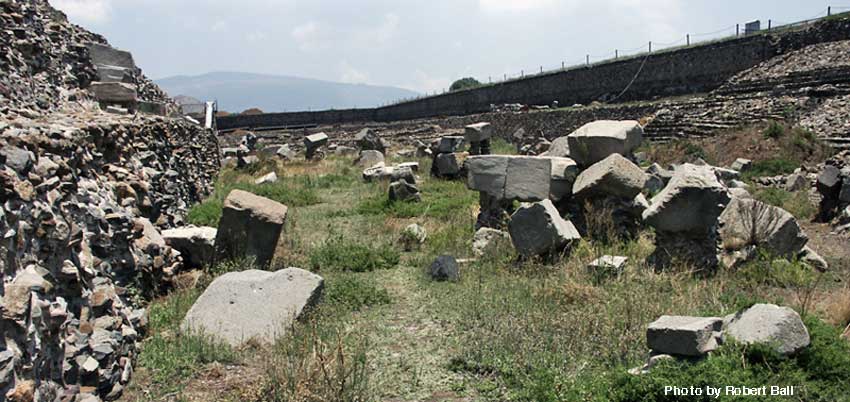 |